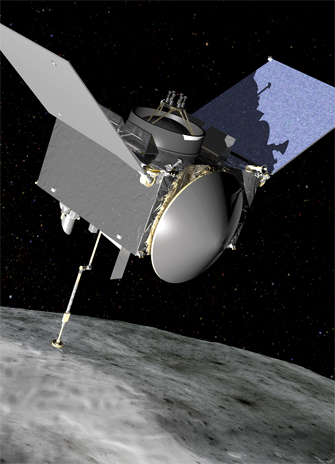OSIRIS-REx – the first-ever sampling mission by NASA to the distant asteroid Bennu – was successfully launched into space on Sept. 8 from Cape Canaveral Air Force Station in Florida. The mission will revolutionize our understanding of asteroids and the origins of the universe. Attending the launch in Florida as the Canadian scientific lead for the mission was Lassonde Professor Michael Daly.

Cheering the launch along (albeit from a distance) was an excited group of York University students from the Lassonde School of Engineering. The students watched the mission unfold through a live stream of the launch on a large screen in the Bergeron Centre for Engineering Excellence at the Keele campus.
Speakers at the event included former student Grant Cunningham, now at Teledyne Optech (an industrial partner involved in the design of the Canadian instrument) who talked about his involvement and his time at York U, and the University’s Vice-President Research & Innovation Robert Haché. As part of the launch celebration, Mariane Mader, managing director of the Royal Ontario Museum’s Earth & Space and Paleontology divisions presented a display table with football sized sample of a meteorite for students and guests to handle and a model of Bennu. To view all the photos from the event, visit the event’s Facebook page here.
“The OSIRIX-REx mission is a prime example of York University expertise being brought to the international table in support of an exceptional collaborative scientific endeavour,” said York Vice-President Research & Innovation Robert Haché. “This project, with York as the lead Canadian university, showcases York’s leadership in space science, which also includes York’s significant contributions to Mars exploration, and demonstrates that there is no limit to where research excellence can take us as students, scholars, and as a university.”

The Planetary Exploration Instrumentation Laboratory at York University played a pivotal role in the instrumentation for the spacecraft. Canada’s contribution to the mission is the OSIRIS-Rex Laser Altimeter (OLA), the most sophisticated laser altimeter ever to visit an asteroid. OLA and the Canadian science team are funded by the Canadian Space Agency. (OSIRIS-REx is the acronym for a the spacecraft’s complicated moniker, namely the Origins, Spectral Interpretation, Resource Identification, Security-Regolith Explorer Spacecraft.)
The OLA will map the surface of the asteroid and create a 3D model of Bennu during the NASA mission. The instrument, which is about the size of two bread boxes, will also help to guide the spacecraft on the OSIRIS-REx Asteroid Sample Return Mission to a safe spot, where it will grab a sample to bring back to Earth.
By contributing the OLA, an advanced LIDAR (Light Detection And Ranging), to the mission, Canada will get a portion of that sample. The mission is expected to return 60 grams of the asteroid, but more than a kilogram is hoped for. It will provide Canadian scientists the first-ever direct access to a pristine asteroid sample, according to the Canadian Space Agency (CSA), which funded the instrument.
The main part of the mission, the proximity operation, starts seven or eight kilometres from the asteroid. It will be a long process of getting to know the asteroid and its non-uniform gravity field well enough to be able to get down and touch the surface and obtain a sample.
As the prime contractor for the CSA, MacDonald, Dettwiler & Associates (MDA), together with its industrial partner Teledyne Optech, designed, built and tested the instrument.
In addition to Daly, the team also includes Professors Alan Hildebrand, University of Calgary; Ed Cloutis, University of Winnipeg; Rebecca Ghent, University of Toronto; and Catherine Johnson, University of British Columbia. The participation of Canadian universities, including York University, in the OSIRIS-REx Mission is made possible in part by $7.83 million in support from the Canadian Space Agency; as well as additional research funds for Daly, who is the principal investigator on the project, from the Canada Foundation for Innovation and the Ontario Research Fund of $1.35 million and $1.34 million respectively; and by a Natural Sciences & Engineering Research Council of Canada (NSERC) Discovery Grant of $384,500 over five years
Why Bennu?

Bennu, which is about 500 metres in diameter, is of particular interest because it is one of the most potentially hazardous asteroids presently identified, with a small chance of hitting Earth in the 22nd century. The mission will allow the team to study and track the asteroid’s orbit, as OLA will provide precise distance measurements from the spacecraft to the rocky surface.
The main part of the mission, the proximity operation, starts seven or eight kilometres from the asteroid. It will be a long process of getting to know the asteroid and its non-uniform gravity field well enough to be able to get down and touch the surface and obtain a sample.
For more on the OSIRIS-REx instrumentation, see the story in the Jan. 5, 2016 issue of YFile.
Videos and images courtesy of NASA’S Goddard Space Flight Center, Greenbelt, Maryland.


